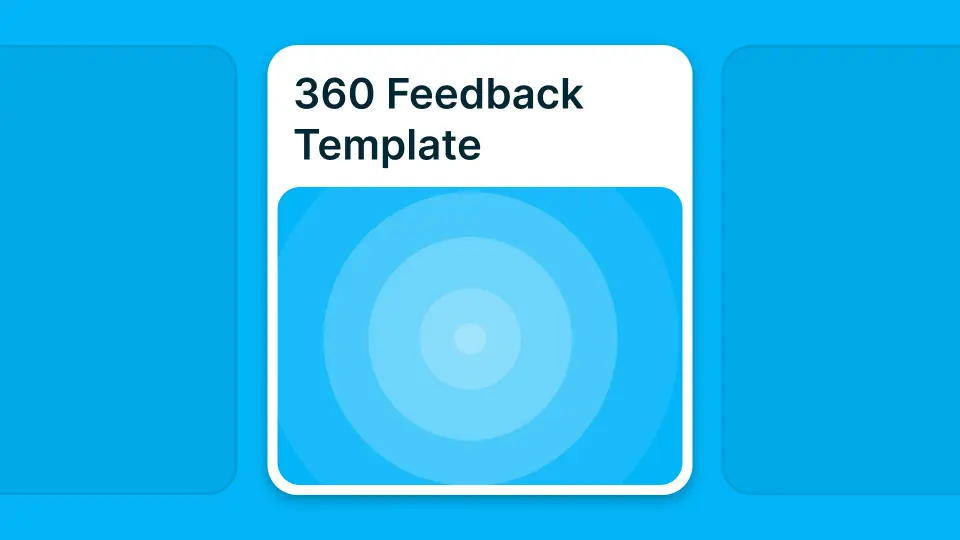Companies using structured 360 degree feedback templates see up to 14% higher employee engagement than those relying on ad-hoc review processes. Yet most HR teams still struggle with inconsistent feedback forms, unclear rating scales, and compliance headaches that derail even well-intentioned performance initiatives.
Here's what you'll gain from this comprehensive guide: ready-to-use 360° feedback forms in Word, Google Docs, and Google Forms formats, plus Excel tracking matrices designed for different role levels. You'll get validated competency libraries, proven rating scale options, and built-in GDPR compliance features—all designed to work across global teams and DACH regulatory requirements.
- Copy-ready 360° feedback templates for individual contributors, managers, and senior leaders
- Editable question libraries covering leadership, collaboration, communication, and problem-solving competencies
- Built-in anonymity options and GDPR compliance notes
- Step-by-step rater instructions and calibration guides
- DACH Works Council (BetrVG) consultation best practices
Let's dive into how you can launch a bias-free, high-impact 360 process without expensive software or months of preparation.
1. Understanding 360 Degree Feedback Templates: Purpose and Impact
Well-designed 360 degree feedback templates serve as the foundation for fair, actionable reviews that work across different cultures and organizational hierarchies. These structured forms eliminate the guesswork from multi-rater feedback while ensuring consistency in how performance data gets collected and analyzed.
Organizations using multi-source reviews reduce turnover by up to 10% compared to traditional top-down appraisal systems. The key difference lies in comprehensive perspective-gathering that reveals blind spots invisible in manager-only evaluations.
Consider how a global tech firm replaced their ad-hoc review conversations with standardized 360 degree feedback templates. Within six months, they saw more consistent leadership development paths across offices in Berlin, Singapore, and Austin. The structured approach helped identify high-potential employees who might have been overlooked in subjective assessment processes.
- Clarify the specific goals of your 360 process before selecting templates
- Match template complexity to role levels—individual contributors need different forms than senior leaders
- Align competency questions with your business strategy and values
- Ensure language remains inclusive and culture-neutral for global teams
- Communicate the purpose and benefits clearly to all raters and recipients
| Template Type | Best For | Example Roles |
|---|---|---|
| Standard Word Doc | Small teams, controlled distribution | Individual contributors |
| Google Forms | Remote teams, automatic data collection | All levels |
| Excel Matrix | Calibration meetings, HR tracking | HR managers, senior leaders |
The main limitation of over-customizing templates involves creating inadvertent bias through inconsistent question structures. Standardization actually improves fairness rather than limiting it. Next, let's examine the actual downloadable templates you can implement immediately.
2. Free Downloadable 360 Degree Feedback Templates: Formats & Variants
Access copy-ready templates in Word, Google Docs, Google Forms, and Excel formats—each tailored specifically for individual contributors, managers, and senior leaders. These professionally designed forms eliminate the need to build feedback systems from scratch while maintaining flexibility for organizational customization.
Over 60% of HR teams now use digital forms for multi-rater feedback, with Google Forms leading adoption due to automatic response collection and real-time tracking capabilities. This shift reflects the practical need for scalable feedback processes that work across distributed workforces.
A mid-sized healthcare provider switched to Google Forms for their quarterly 360 reviews after struggling with paper-based distribution across 12 clinic locations. The digital template system reduced administrative time by 70% while improving response rates from 45% to 78% within one review cycle.
- Choose editable formats based on your IT security policies—Word/Google Docs for controlled sharing, Google Forms for automated collection
- Use role-specific versions that match competency expectations for individual contributors, managers, and senior leaders
- Update template questions annually to reflect evolving competencies and business priorities
- Pre-populate rater instruction sections to ensure consistency across all feedback sessions
- Prepare translated versions for global teams operating in multiple languages
| Template Name | Format | Role Coverage | Key Features |
|---|---|---|---|
| IC Feedback Questionnaire | Word/Google Doc | Individual Contributor | Technical skills focus, peer collaboration |
| Manager Feedback Survey | Google Form | People Manager | Leadership competencies, team development |
| Leadership Rater Matrix | Excel/Sheets | Senior Leader | Strategic thinking, organizational impact |
| Cross-functional Template | Google Form | All levels | Adaptable questions, custom competencies |
These templates integrate seamlessly with performance management systems and can be customized using advanced AI tools that suggest relevant questions based on past feedback patterns and automatically summarize results for easier interpretation.
Now that you have access to the right template formats, the next critical step involves customizing them with validated competencies that match your organizational needs.
3. Competency Libraries & Sample Questions for Every Level
Using validated competency libraries ensures your 360 degree feedback template captures relevant behavioral indicators rather than generic performance metrics. Focus areas typically include leadership, collaboration, communication, problem-solving, and customer focus—each requiring different question approaches based on role level and responsibilities.
Firms using structured competency libraries report a 12% increase in perceived fairness compared to organizations that rely on improvised feedback questions. This improvement stems from consistent evaluation criteria that employees understand and trust as relevant to their professional development.
A logistics company mapped its five core values—innovation, teamwork, accountability, customer service, and safety—to specific behavioral questions in their manager-level 360 degree feedback template. The structured approach helped identify that their highest-performing supervisors consistently scored well on accountability and safety but needed development in innovation and teamwork competencies.
- Match competency selections to specific job families or business units rather than using generic frameworks
- Select from proven question banks that focus on observable behaviors rather than abstract traits
- Mix quantitative rating scales with qualitative open-ended prompts for richer developmental insights
- Review question clarity and potential bias risks through pilot testing with diverse rater groups
- Include forward-looking sections that ask about potential and growth areas, not just current performance
| Competency | IC Sample Question | Manager Sample Question | Senior Leader Sample Question |
|---|---|---|---|
| Collaboration | "Shares knowledge and resources openly with team members" | "Facilitates effective collaboration across different teams" | "Builds strategic partnerships that drive organizational success" |
| Communication | "Communicates ideas clearly in meetings and written updates" | "Adapts communication style to different audiences and situations" | "Articulates compelling vision and strategy to stakeholders" |
| Problem Solving | "Identifies creative solutions to technical challenges" | "Guides teams through complex problem-solving processes" | "Makes strategic decisions with incomplete information" |
| Leadership | N/A (role-appropriate) | "Inspires and motivates team members toward shared goals" | "Develops organizational capabilities and future leaders" |
Modern AI-powered platforms can analyze your organization's historical feedback data to suggest high-impact questions that have previously led to meaningful development conversations and measurable performance improvements.
With competency questions established, selecting the right rating scale becomes crucial for generating actionable data that raters can use consistently.
4. Rating Scales Explained: Choosing Between 3-, 5-, or 7-Point Options
The right rating scale balances detailed feedback with user-friendly simplicity. While complex scales might seem more sophisticated, research consistently shows that overly complicated rating systems reduce response quality and increase completion time without providing proportional value.
Five-point scales deliver optimal reliability in peer feedback according to multiple Harvard Business Review studies. This sweet spot provides enough granularity for meaningful distinctions while remaining intuitive for raters who complete multiple 360 degree feedback templates during review cycles.
An international NGO discovered this balance when they moved from binary Yes/No rating options to a five-point Likert scale format. The change doubled the actionable insights generated from peer reviewers, particularly in identifying specific development opportunities that had been invisible in the previous system.
- Consider your audience's familiarity with rating systems when selecting scale length and complexity
- Define each rating point clearly in rater instructions with specific behavioral examples
- Use odd-numbered scales to provide a neutral midpoint option for situations where raters have limited observation
- Avoid ambiguous descriptors like "average," "good," or "satisfactory" that mean different things to different people
- Pilot test your chosen scale with a small group before full organizational rollout
| Scale Type | Points | Typical Labels | Best Use Case |
|---|---|---|---|
| Simple | 3 | Needs Improvement / Meets Expectations / Exceeds Expectations | Quick pulse surveys, new organizations |
| Standard Likert | 5 | Strongly Disagree / Disagree / Neutral / Agree / Strongly Agree | Most organizational contexts |
| Behavioral Frequency | 5 | Never / Rarely / Sometimes / Often / Always | Observable behavior focus |
| Advanced Granular | 7 | Detailed behavior-specific statements | Senior leadership, high-stakes decisions |
Modern 360 degree feedback software offers customizable scaling options that can adapt to different competency areas within the same template—using frequency scales for observable behaviors and agreement scales for attitude-related questions.
Beyond rating mechanics, ensuring anonymity and data privacy becomes essential for honest feedback and legal compliance, especially under GDPR and DACH regulations.
5. Ensuring Anonymity & Data Privacy: Rater Instructions and GDPR Essentials
Anonymity increases feedback honesty by over 30% according to Gallup research, while clear privacy protections and comprehensive rater instructions become essential for compliance—particularly under EU GDPR requirements and DACH Works Council regulations that govern employee data collection and processing.
Anonymous feedback systems generate significantly higher response rates and more candid developmental insights. However, true anonymity requires careful technical setup and explicit communication to all participants about how their data will be collected, stored, and used in accordance with privacy regulations.
A German manufacturing company collaborated with their Works Council to co-design privacy language for their Excel-based 360 degree feedback template system. This proactive approach eliminated later compliance issues while building employee trust in the feedback process through transparent data handling practices.
- Include clear confidentiality statements at the beginning of every 360 degree feedback template
- Provide step-by-step rater guidance with concrete examples of constructive feedback language
- Configure Google Forms and similar tools to disable email collection for guaranteed anonymity
- Document your GDPR-compliant data retention and deletion policies in writing
- Engage Works Councils early in the design process if operating in Germany, Austria, or Switzerland
| Privacy Element | Required? | GDPR Compliance | DACH Considerations |
|---|---|---|---|
| Anonymous response collection | Strongly advised | Reduces data processing risks | Builds Works Council trust |
| Explicit privacy clauses | Mandatory in EU | Legal requirement | BetrVG consultation needed |
| Data retention timeline | Must specify | Right to deletion | Co-determination rights |
| Rater instruction clarity | Best practice | Informed consent | Cultural sensitivity |
Comprehensive rater instructions should explain not just how to complete the 360 degree feedback template, but why their honest input matters for colleague development. Include examples of constructive phrasing and remind raters that their goal is supporting growth, not judgment.
With privacy protections in place, the next challenge involves calibration and bias mitigation to ensure fair, accurate feedback across all participants and raters.
6. Calibration & Bias Mitigation Strategies
Calibration sessions ensure scoring consistency across different raters and departments, while proactive bias identification reduces systematic errors that can undermine the credibility of your entire 360 degree feedback template system. These quality control measures become particularly important in global organizations where cultural differences in feedback styles can create unintended disparities.
Calibrated reviews improve perceived fairness by up to 20% according to McKinsey research on performance management effectiveness. This improvement results from systematic review of rating patterns and collaborative discussion of scoring rationales among HR teams and managers.
A US-based SaaS company holds quarterly calibration meetings where HR professionals moderate scoring differences between engineering, sales, and customer success departments. These sessions revealed that sales managers consistently rated collaboration higher than engineering managers for identical behaviors, leading to adjusted interpretation guidelines.
- Schedule post-review calibration meetings across different functions and departments
- Train all raters on common bias types before launching your 360 degree feedback template
- Use anonymized result dashboards during moderation sessions to focus on patterns rather than individuals
- Track inter-rater reliability metrics over multiple review cycles to identify systematic issues
- Leverage AI-powered tools for automated flagging of statistical outliers and unusual rating patterns
| Bias Type | Example Scenario | Mitigation Method | Template Adjustment |
|---|---|---|---|
| Recency bias | Overweighting recent events or projects | Ask for year-round examples | Include time-range prompts |
| Halo effect | One strong trait influences all ratings | Separate ratings per competency | Clear section breaks |
| Leniency bias | Consistently high scores across all areas | Norm group benchmarking | Forced ranking options |
| Cultural bias | Different feedback norms by region | Localized rater training | Cultural context notes |
Advanced performance management systems can integrate directly with your 360 degree feedback templates to provide automated bias detection algorithms that flag unusual patterns for human review during calibration sessions.
Once calibration ensures fair scoring, the final critical step involves interpreting results effectively and translating insights into actionable development plans that drive real performance improvements.
7. Interpreting Results & Driving Action: From Insights to Development Plans
Simply collecting 360 degree feedback data accomplishes nothing without systematic interpretation and action planning. Effective results analysis transforms raw rating scores into personalized development roadmaps that address specific strengths and growth opportunities identified through the multi-rater process.
Teams that actively create development plans based on 360 review results improve performance by an average of 8% according to CEB research. This improvement requires more than just sharing scores—it demands facilitated interpretation sessions and concrete next-step planning.
A fintech startup implemented automated result summarization to identify the top three strengths and development areas for each leader who completed their 360 degree feedback template. These AI-generated summaries fed directly into personalized coaching plans and quarterly development check-ins, creating accountability for acting on feedback insights.
- Aggregate individual results into visual formats like heatmaps or competency radar charts for easier interpretation
- Generate automated summaries highlighting key strengths and priority development areas for each person
- Facilitate structured one-on-one debriefing conversations between managers and direct reports after sharing results
- Link feedback findings directly to internal learning resources, external training programs, or coaching opportunities
- Schedule systematic follow-up checkpoints six months after feedback delivery to track development progress
| Insight Category | Sample Finding | Possible Action | Success Metric |
|---|---|---|---|
| Collaboration Gap | Low peer ratings on knowledge sharing | Join cross-functional project team | Increased collaboration scores |
| Communication Strength | High ratings on presentation skills | Mentor junior colleagues, lead training | Team communication improvement |
| Leadership Opportunity | Mixed scores on decision-making | Shadow senior leader, take decision-making course | Confidence in leadership scenarios |
| Technical Excellence | Consistent high performance ratings | Lead innovation project, share expertise | Business impact from technical contribution |
Modern AI-powered systems can automatically analyze patterns across multiple 360 degree feedback templates to suggest personalized development actions based on what has worked for others with similar competency profiles and organizational contexts.
The most effective organizations treat 360 feedback as an ongoing developmental conversation rather than an annual event, using results to inform career planning, succession discussions, and team composition decisions throughout the year.
Conclusion: Building Sustainable Feedback Systems Through Structured Templates
Three critical insights emerge from implementing effective 360 degree feedback templates across diverse organizations. Well-designed templates with validated competency libraries generate significantly more actionable insights than ad-hoc feedback approaches. Clear rating scales and comprehensive rater instructions eliminate confusion while improving response quality and completion rates. Finally, robust privacy protections and bias mitigation strategies build trust that encourages honest, developmental feedback.
Your next steps should focus on selecting the most appropriate template format for your organizational context—whether Word documents for small teams, Google Forms for distributed workforces, or Excel matrices for detailed calibration processes. Align your competency questions with specific business priorities rather than generic frameworks, and schedule regular calibration sessions to maintain fairness across different departments and cultural contexts.
The future of 360 feedback increasingly relies on AI-driven automation for question suggestion, bias detection, and result summarization. Expect continued evolution toward more sophisticated privacy requirements globally, while template-based approaches remain essential for ensuring consistency and compliance across complex organizational structures.
Frequently Asked Questions (FAQ)
What is a 360 degree feedback template and how does it work?
A 360 degree feedback template is a structured form used to collect performance insights from multiple sources like peers, managers, direct reports, and sometimes customers. It typically includes standardized questions on key competencies plus rating scales or open comment sections. These templates help ensure fair comparisons across roles while supporting actionable development plans through consistent data collection methods.
Are responses really anonymous when I use these free Google Forms or Word documents?
Yes, if configured correctly. In Google Forms you can disable email collection so responses remain completely anonymous. For Word or Google Docs templates, distribute them through anonymous channels and collect responses without identifying information. Always add clear confidentiality statements and consult your Works Council before rollout in DACH regions to ensure compliance with co-determination requirements.
Which rating scale should I pick for my team's 360 degree feedback template?
Most organizations achieve optimal results with five-point Likert scales—they're intuitive for raters while providing sufficient nuance for meaningful feedback. Three-point scales work well for rapid pulse surveys or organizations new to structured feedback. Seven-point versions offer extra granularity but may confuse raters if behavioral anchors aren't clearly defined in your template instructions.
How many raters should participate in an effective multi-source review process?
Research indicates that at least five raters from different perspectives balances bias reduction with practical feasibility. Mix direct supervisors with peers, direct reports (for managers), and internal customers when relevant. More than ten raters typically doesn't improve insight quality but increases administrative burden and completion time for your 360 degree feedback template process.
Can I use these 360 degree feedback templates internationally including DACH countries?
Absolutely. The provided templates are designed for global use with specific localization guidance for German-speaking regions. Built-in GDPR privacy clauses ensure EU compliance, while DACH-specific notes address Works Council consultation requirements under BetrVG regulations. Simply translate competency questions while maintaining the core structure for consistent international implementation.












